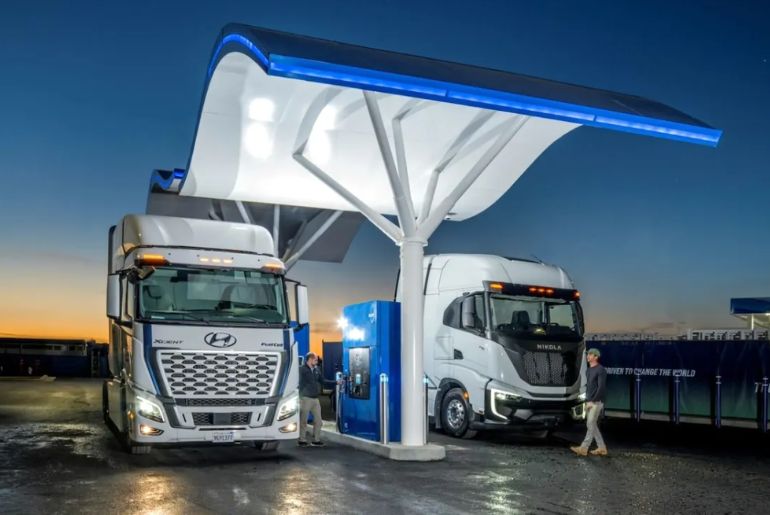Just outside the Port of Oakland, FirstElement Fuels has established the first large-scale hydrogen filling station for heavy-duty commercial vehicles in the world.
This week, FirstElement unveiled its new filling station to the public for tours and demonstrations. They are referring to it as the first of its type. The business, which is close to the Port of Oakland, says that its hydrogen pumps can “fill” a truck’s hydrogen tank in as little as 10 minutes, which, according to its calculations, equates to up to 200 trucks a day. Regarding clients, the business reports that 30 Hyundai Xcient semi trucks and several Nikola hydrogen fuel-cell-powered vehicles are presently utilising the fuelling station.
A ceremony to mark the station’s opening was held and was attended by state officials including Liane Randolph, chair of the California Air Resources Board (CARB) and Tyson Eckerle, clean transportation advisor for Gov. Gavin Newsom’s business development office. Primary funding for the Oakland station was provided by CARB and the California Energy Commission.
Eckerle notes that the US federal government is handing out $8 billion to jump-start what it calls the “hydrogen economy,” and expects sufficient funding to build up to 60 more hydrogen truck stations like this one in California – which would, theoretically, be enough to serve 5,000 trucks and 1,000 buses.
MAN Trucks CEO, Alexander Vlaskamp, said it best when he said that it was “impossible” for hydrogen to effectively compete with BEVs.
He’s right – on a level playing field, there is no reason to believe hydrogen has any kind of future. But we don’t operate on a level playing field, and comments like Eckerle’s, along with an $8 billion federal budget and some supposedly genuine industry experts touting its usefulness as a fuel, mean we have to take hydrogen seriously (at least, for now).
Even so, it seems like the tide of public opinion is already starting to turn against hydrogen. Outlets that may never have questioned a manufacturer’s claims about a hydrogen-fueled vehicle a few years ago now seem more than willing to call those claims out.
Producing hydrogen itself can be very dirty. Most hydrogen produced today requires methane, which is a fossil fuel and a strong greenhouse gas contributor. The industry is working on production alternatives, including carbon capture and storage from the burning of methane, or quitting methane altogether to make green hydrogen, using an electrolyzer to split water’s hydrogen and oxygen. Both alternatives are prohibitively expensive without government subsidies.
So far, it’s not clear that claims of FirstElement about either the sustainability of its hydrogen or the practicality of its filling station will convince many battery electric absolutists.
Take the company’s hydrogen production process as an example. FirstElement says that its supplier, Air Liquide in Las Vegas, uses natural gas as “feedstock” for its hydrogen. It buys biogas to blend with natural gas to create hydrogen – and, because the gas used is more than 60% renewable, the hydrogen qualifies as “green.”
Additionally, the claim of 10-minute fast fills should come with an asterisk or two. That’s because FirstGreen is using new “cryopump” technology from Bosch Rexroth to allow for filling at 900 bar (15,000 psi). While that seems like enough to push 100 kg into a tank in about ten minutes, cryogenically cooling hydrogen is an energy-intensive technology that requires a lot of electricity to function properly. The electricity that it says will come from the stored hydrogen.
In fairness, however, Bosch has some ideas here to help station owners maximize the usefulness of all that electricity.
“Cold is like gold,” says Dave Hull, regional vice-president, Bosch Rexroth. “You’ve got all this cold energy. All my career I worked to get rid of heat. You can take that energy and run a whole station’s refrigerators for Rock Star energy drinks, or air conditioning. Bosh has a whole division of heat pumps and building technologies.”
Whether or not that added efficiency adds up to actual energy and cost savings, rather than a lifeline for the gas industry and tier 1 auto suppliers like Bosch however, remains to be seen. Meanwhile, hydrogen costs continue to rise.
Platts last assessed California’s retail hydrogen price at $33.48/kg Jan. 4, 2023, which is the weighted average hydrogen price offered at retail fueling stations across the state. The price has risen 112% from when Platts began the assessment in September 2021, according to S&P Global Commodity Insights data.
Despite the high cost of hydrogen (“green” hydrogen is more expensive, still), Shane Stephens, one of founders of FirstElement and its chief development officer, remains undeterred.

